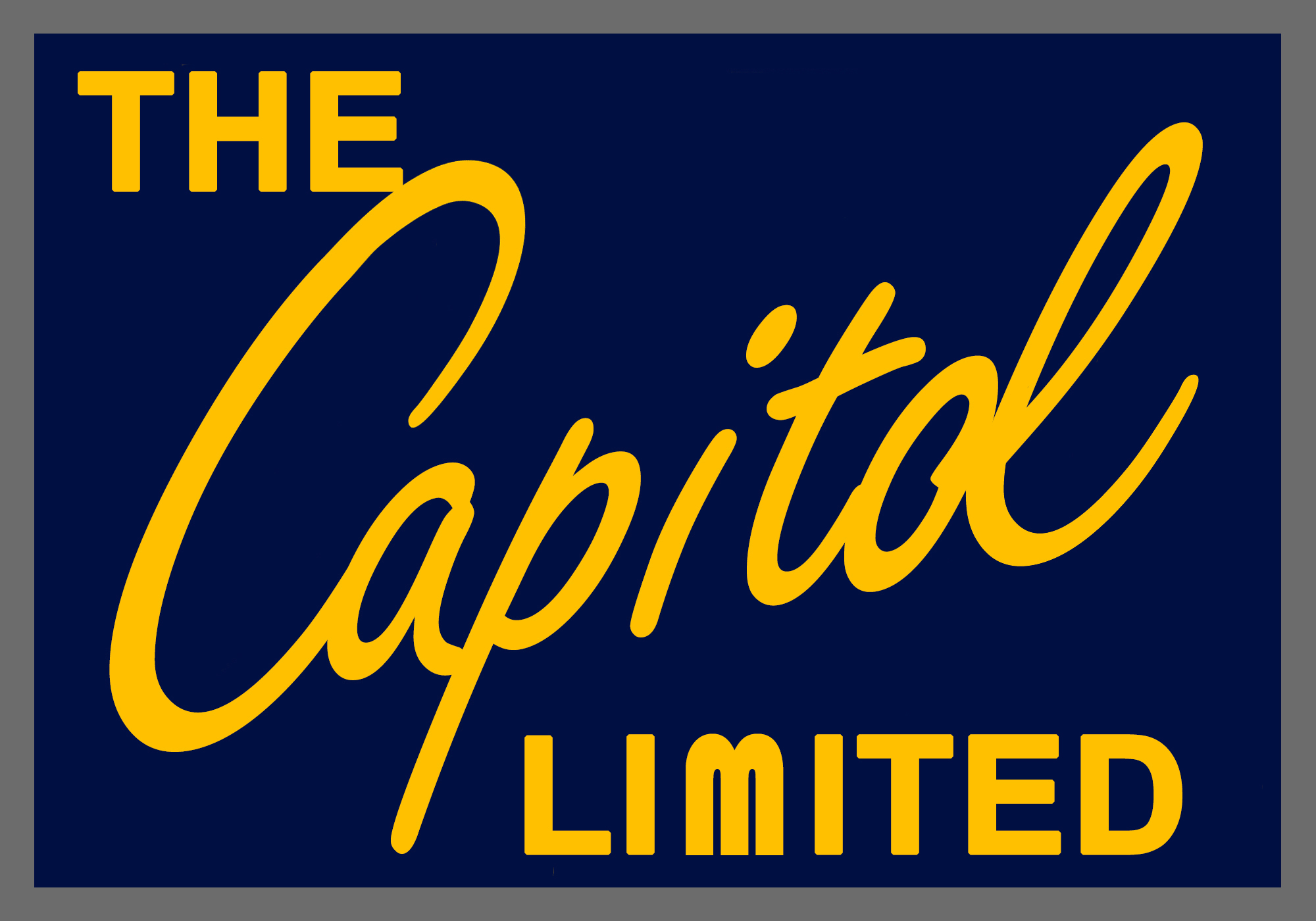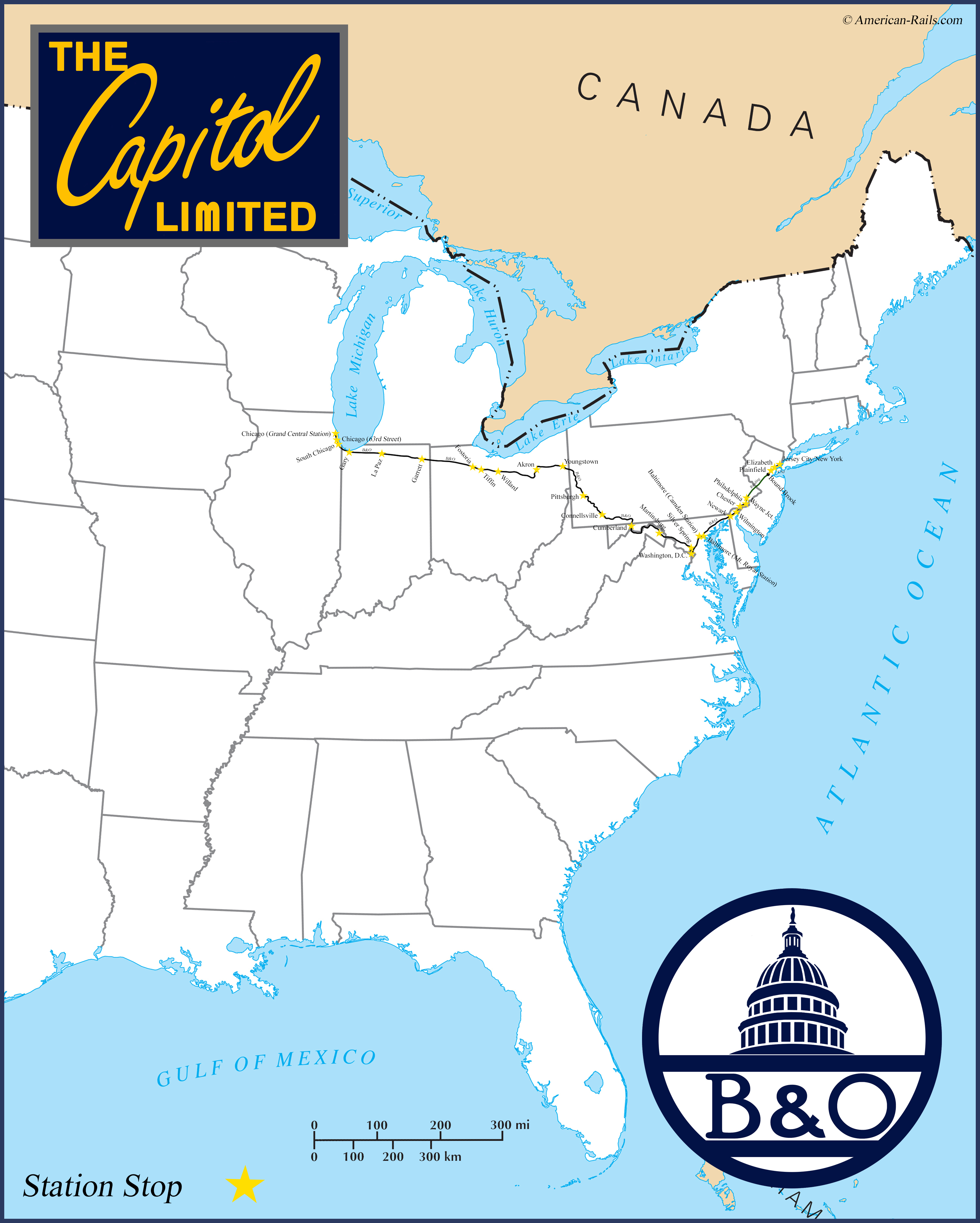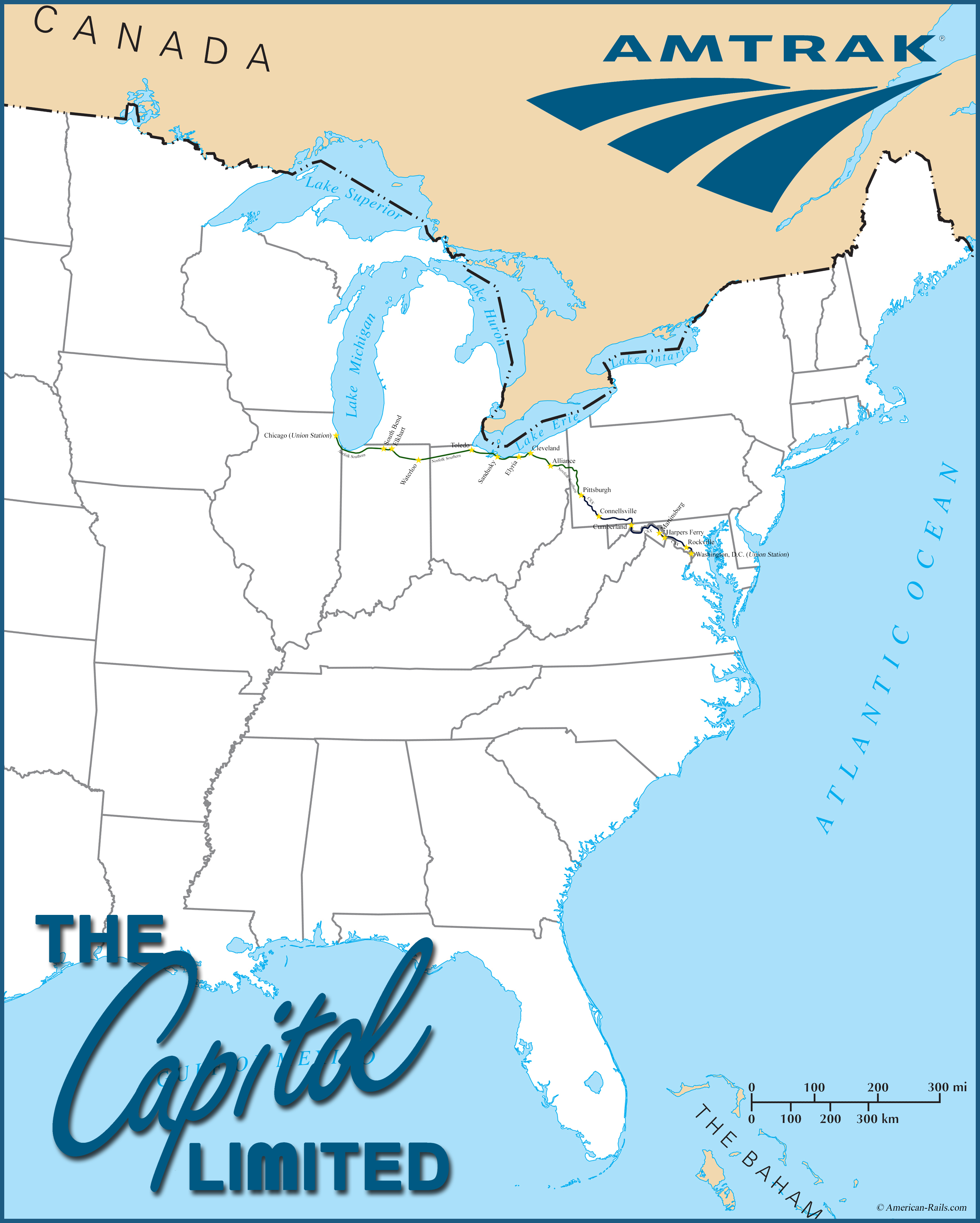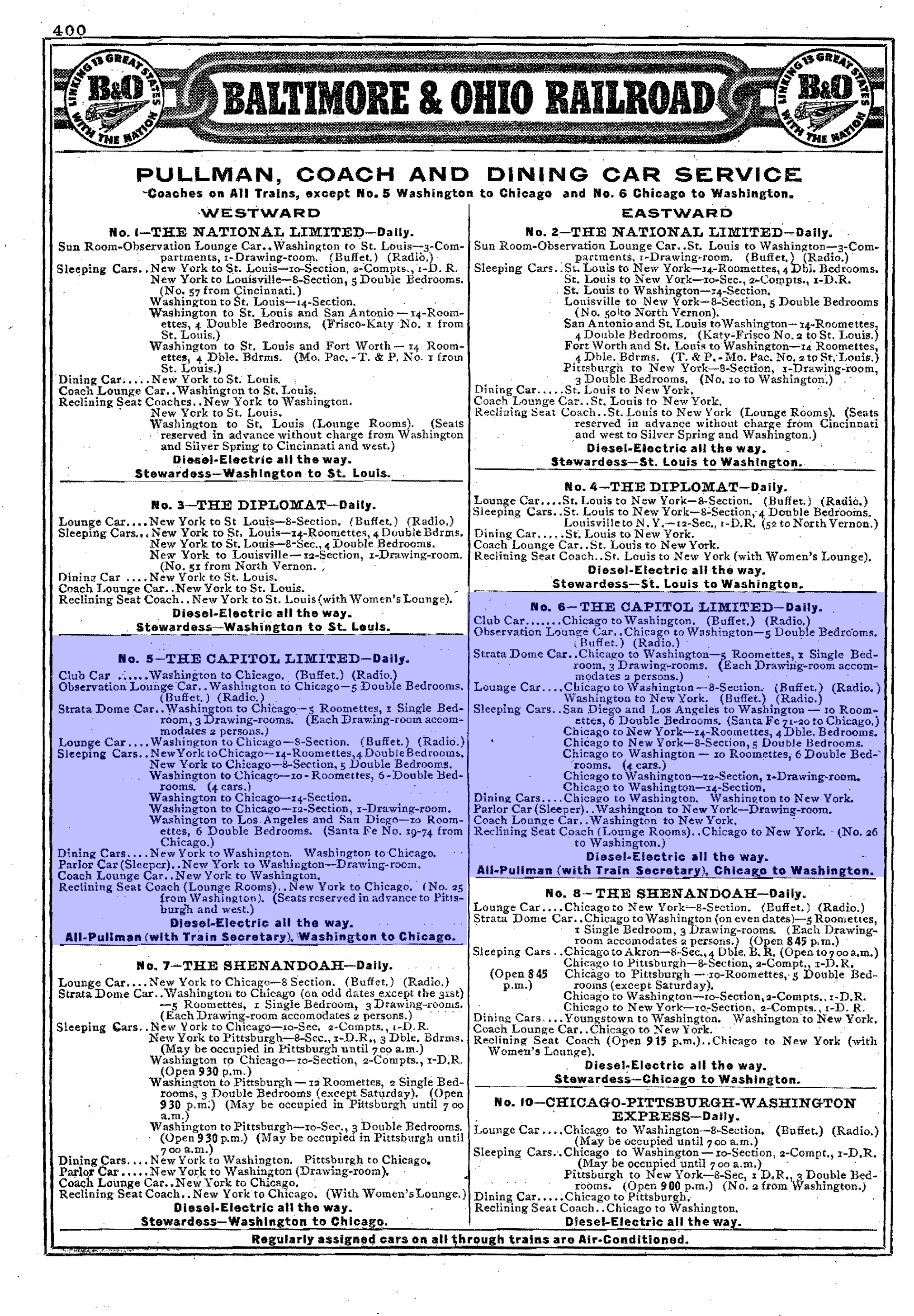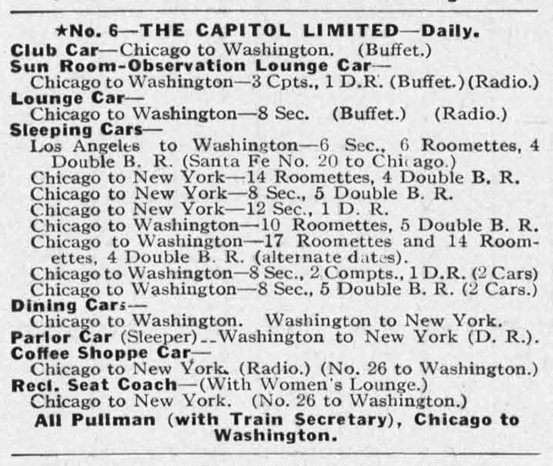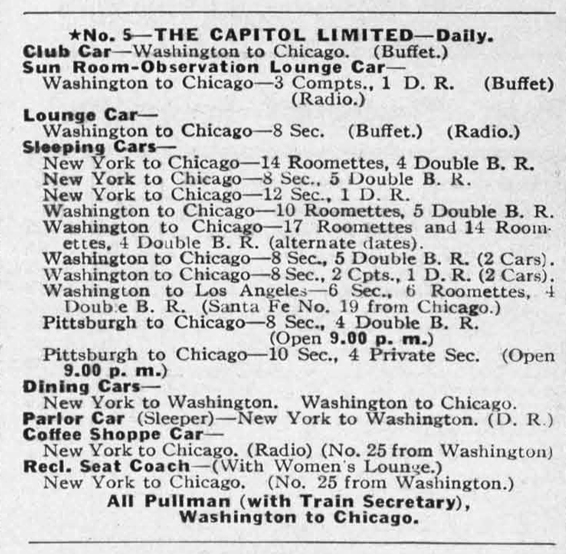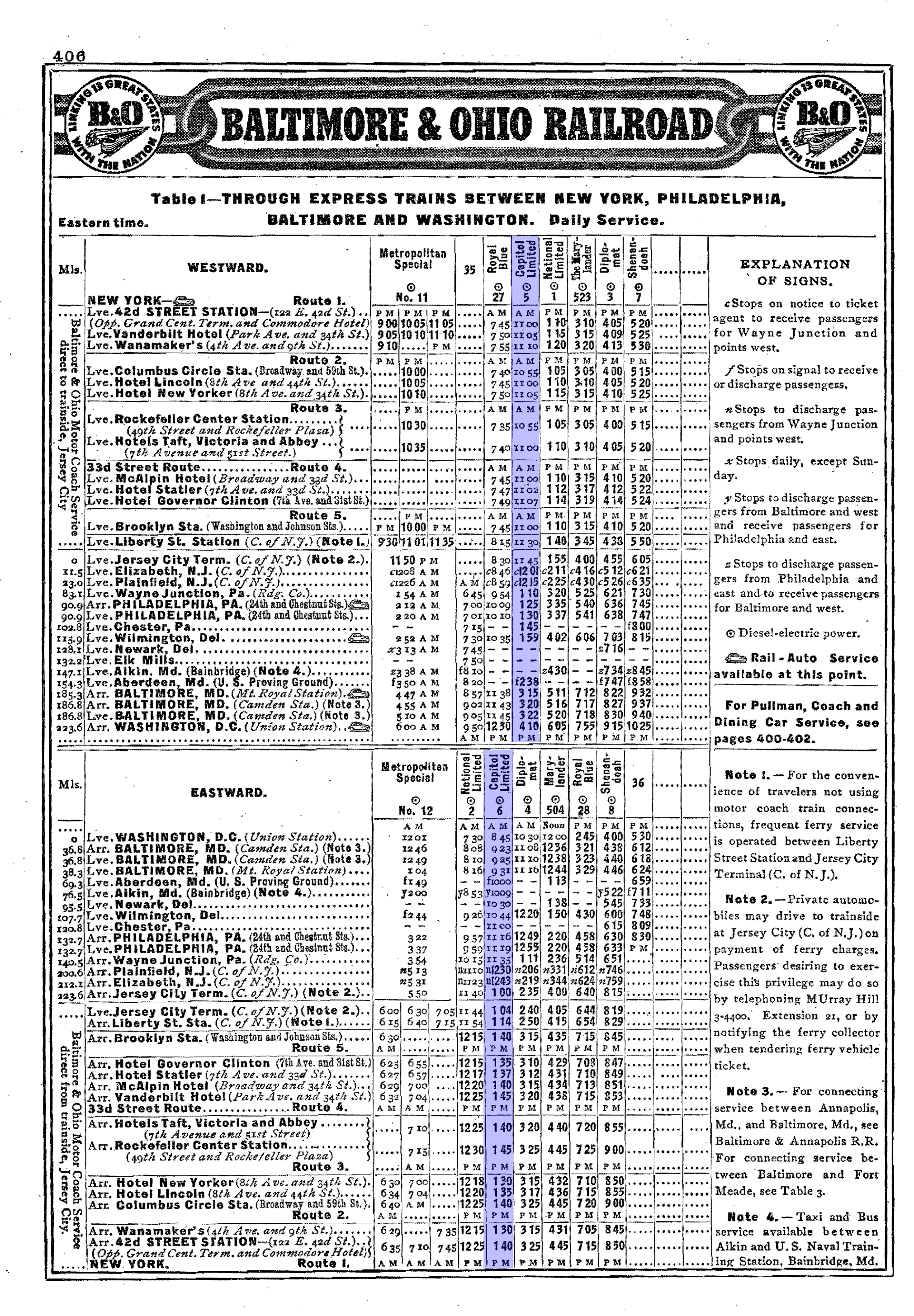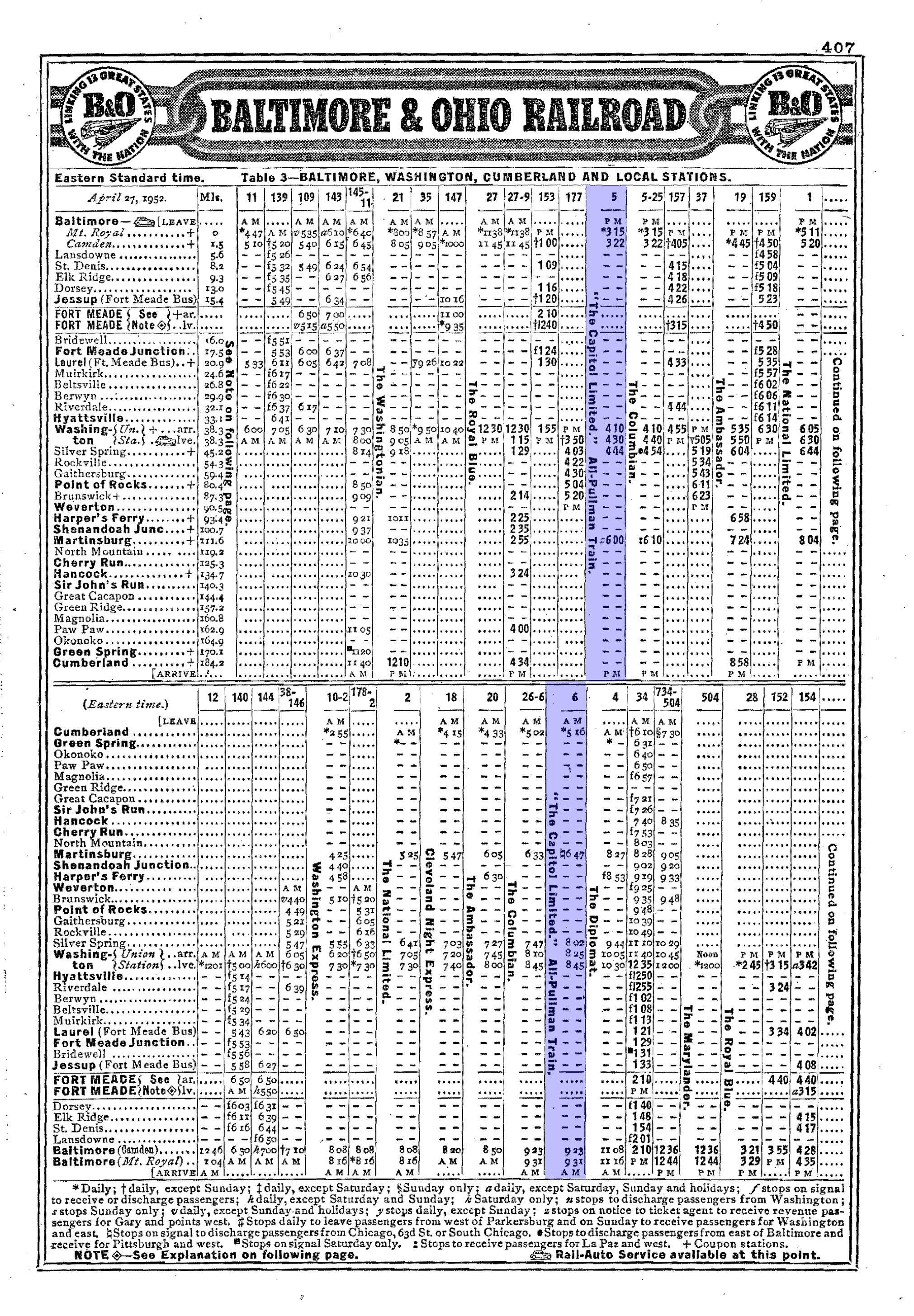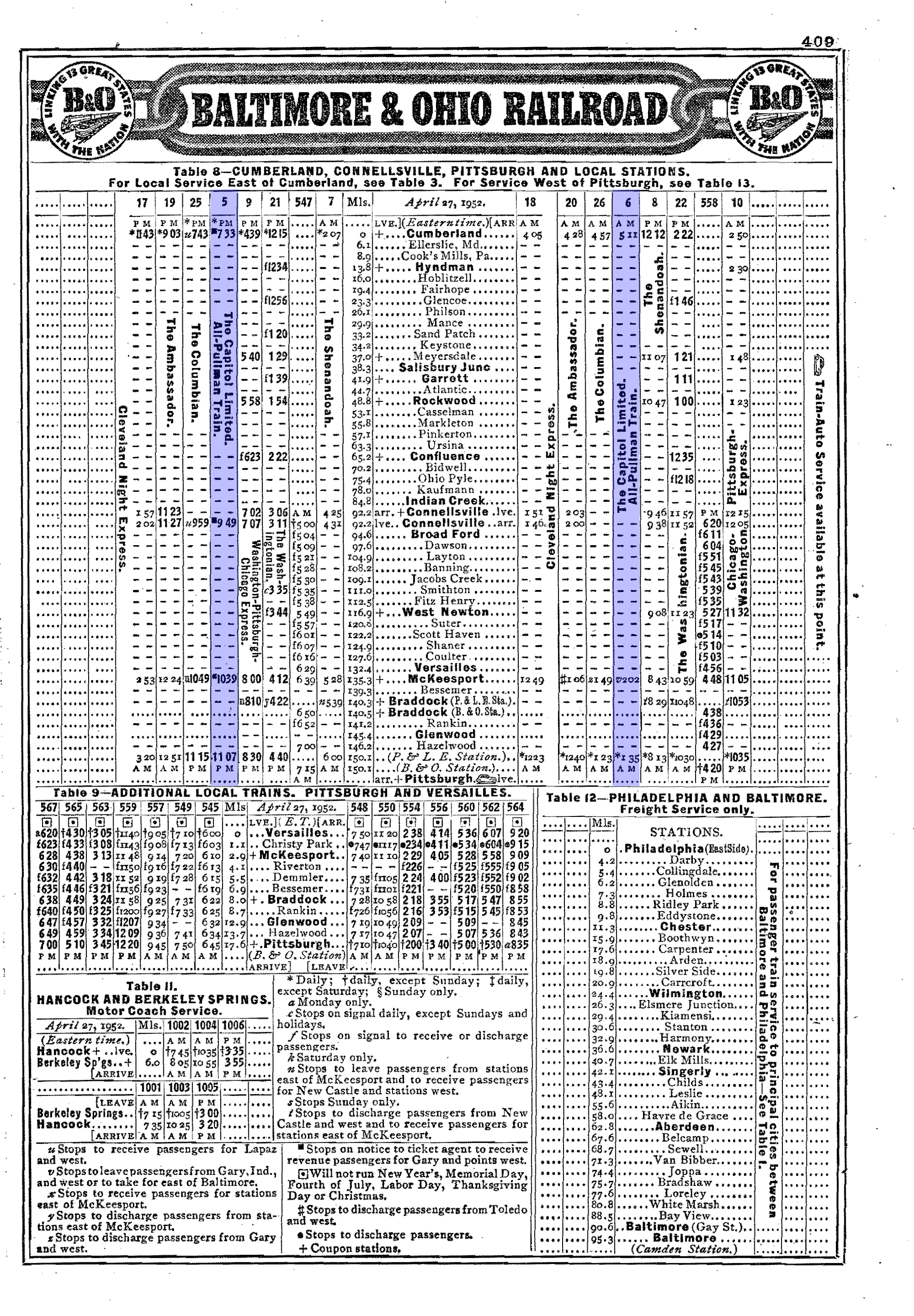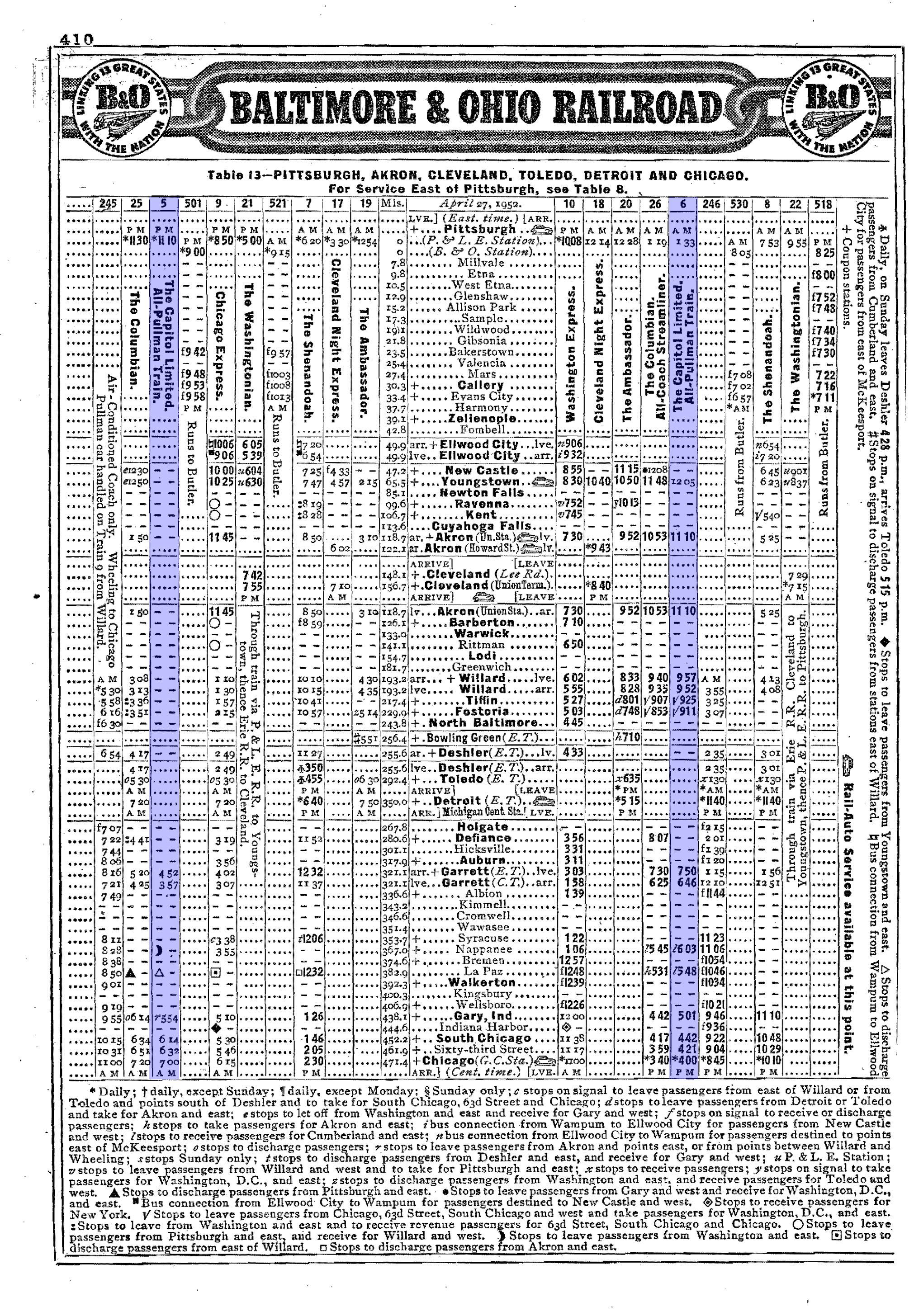"Capitol Limited" (Train): Schedule, Route, Consist, History
Last revised: February 28, 2025
By: Adam Burns
The Baltimore & Ohio’s premier New York-Chicago passenger train, the
Capitol Limited, was born as much out of necessity as anything else.
Ever the underdog in the New York-Chicago market, the B&O knew it needed to keep pace against its two stronger competitors and introduce a train that would strongly rival both the 20th Century Limited and Broadway Limited.
History
While the PRR and NYC had inaugurated their trains in 1902 (the Penny's train, however, was not called the Broadway Limited until 1912) the B&O did not enter the market until 1923 when that year on May 12 it introduced the Capitol Limited (sometimes affectionately referred to as the Cap).
The B&O was always a distance third in the eastern trunk line market but nevertheless maintained an impressive fleet of trains. Names like the Capitol Limited, National Limited, Royal Blue, and others were held in high esteem by the press and public.
While services reduced as patronage waned the railroad maintained its remaining trains to high standards until the end in 1971.
Photos
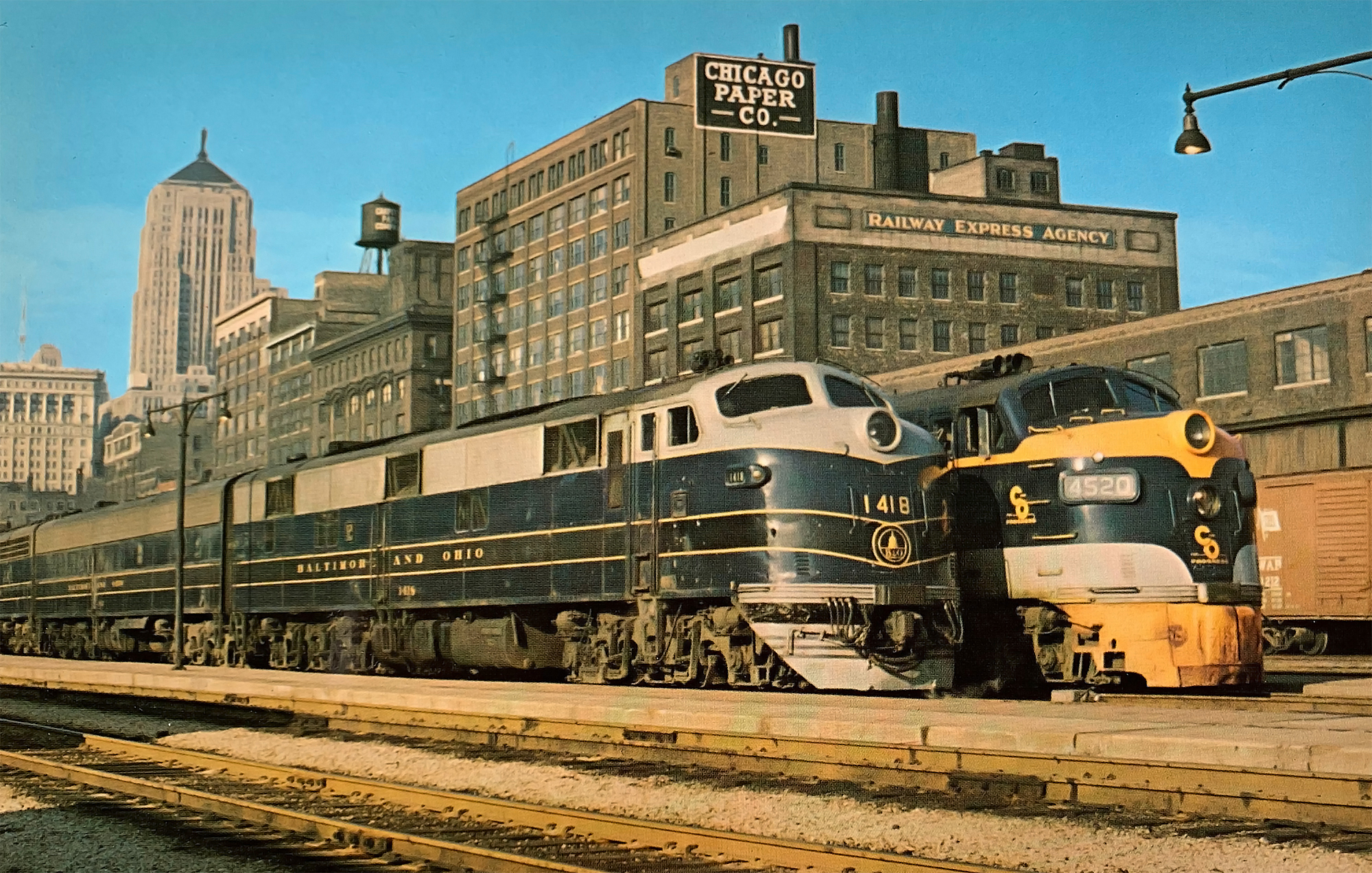 In this Baltimore & Ohio publicity photo, circa 1962, the eastbound "Capitol Limited" awaits departure from Chicago's Grand Central Station while sitting alongside a Chesapeake & Ohio "Pere Marquette." American-Rails.com collection.
In this Baltimore & Ohio publicity photo, circa 1962, the eastbound "Capitol Limited" awaits departure from Chicago's Grand Central Station while sitting alongside a Chesapeake & Ohio "Pere Marquette." American-Rails.com collection.The Baltimore & Ohio’s inability to effectively compete against the New York Central and Pennsylvania railroads in the hotly contested New York-Chicago market was threefold; a longer route, indirect access to downtown Manhattan, and prolonged financial struggles.
Not only was the B&O unable to access New York City directly (indirect entry occurred via the Central Railroad of New Jersey's Jersey City Terminal using ferry service across the Hudson River) but also its route to the Midwest was filled with stiff grades over the Alleghenies.
Drumhead
By comparison, the NYC and PRR both operated relatively level main lines across Pennsylvania/New York, Ohio, and Indiana. To compensate for these disadvantages the B&O provided personal, courtesy service and exquisite dining for which it became legendary.
Many of these amenities included secretaries, barbers, manicures, and valets, and fine Chesapeake Bay cuisine offered on exquisite dinnerware with colonial-style furniture.
At A Glance
20 Hours, 45 Minutes (Westbound) 20 Hours, 40 Minutes (Eastbound) |
|
May 12, 1923 - April 30, 1971 (Baltimore & Ohio) May 1, 1971 - Present (Amtrak) |
|
5 (Westbound) 6 (Eastbound) | |
Grand Central Station (Chicago) Communipaw Terminal (Jersey City, New Jersey) |
For the first three years of its existence the Capitol Limited was somewhat successful in the New York market as the B&O was under contract with the PRR to terminate its trains directly into the city at Pennsylvania Station.
However, this changed in the late summer of 1926 when the PRR ended the contract and the B&O was once again forced back into Jersey City (despite this the railroad made the ferry service as pleasant as possible, promoting friendly and prompt bus service into Manhattan, a move that for a time was actually quite successful).
In 1938 the Capitol Limited got a big boost when the B&O equipped the train with the Electo-Motive Corporation’s brand new, self-contained and streamlined diesel-electric locomotive, the EA.
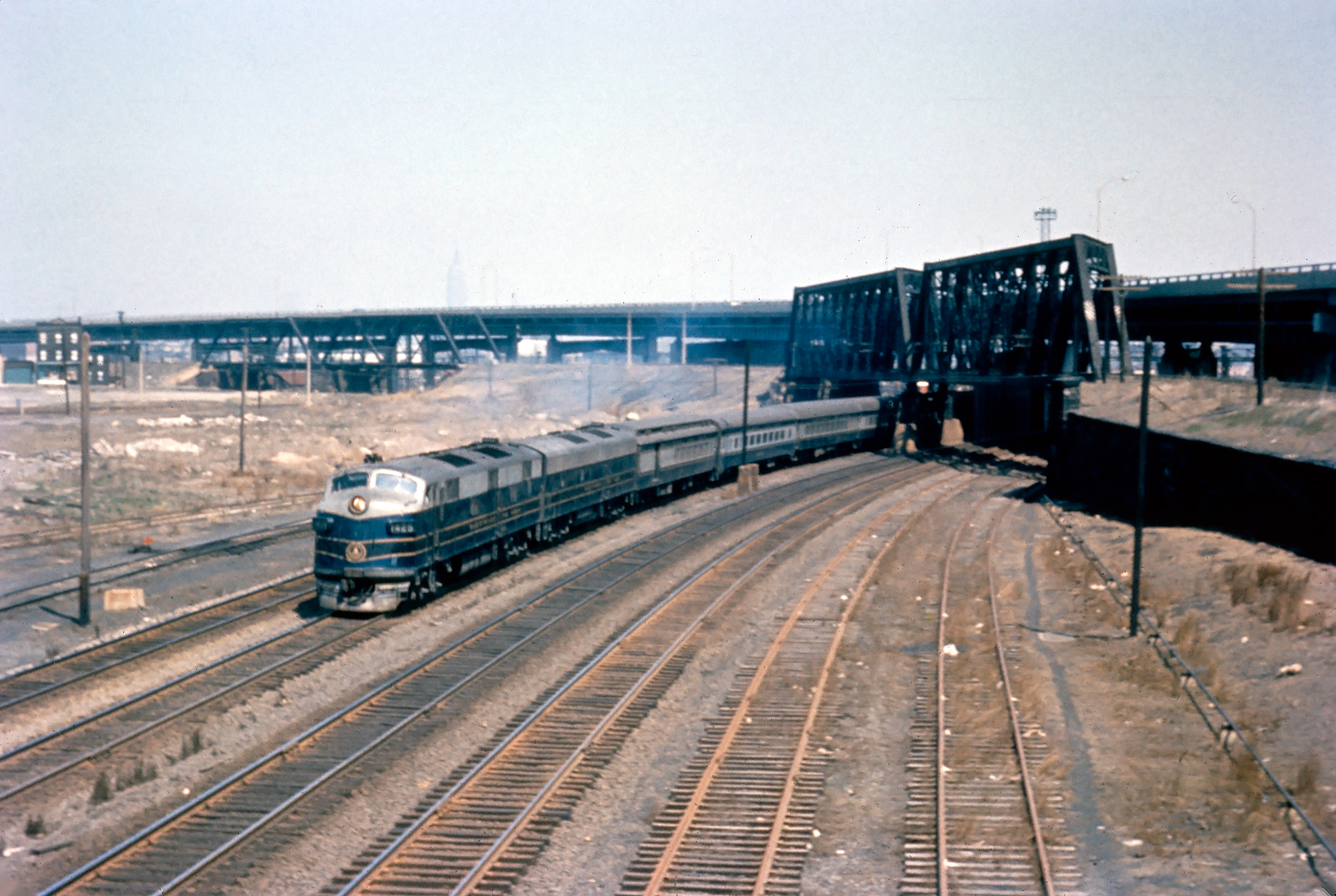 Running over the Jersey Central, Baltimore & Ohio's westbound "Capitol Limited" has just departed Communipaw Terminal in Jersey City, New Jersey, circa 1956. Up front is pair of E7's, led by #1425. Meyer Pearlman photo. American-Rails.com collection.
Running over the Jersey Central, Baltimore & Ohio's westbound "Capitol Limited" has just departed Communipaw Terminal in Jersey City, New Jersey, circa 1956. Up front is pair of E7's, led by #1425. Meyer Pearlman photo. American-Rails.com collection.Not only was the diesel streamlined but the ever-resourceful B&O, not satisfied with the light-weight, aluminum cars it had purchased for its first streamliner, the Royal Blue, turned to its Mount Clare Shops in Baltimore.
The forces there used traditional heavyweight equipment and gave the cars streamlining to match the EA/EB set. What resulted, with the help of renowned industrial designer Otto Kuhler was a stunning train with one of the all-time classic liveries; royal blue, silver, and gold pin-striping.
Route Map (B&O)
While the B&O won over the hearts of many with its splendid services and on board offerings (later amenities included air-conditioning and strata-dome car service, giving passengers a 360-degree view of the surrounding landscape) it simply could not compete with the PRR and NYC to New York.
Route Map (Amtrak)
As a result on April 26, 1958 the B&O gave up all service to New York and began terminating its trains only as far east as Baltimore.
However, unlike many other railroads the B&O did not let its passenger service slide away, and die a slow death. Right until the end the railroad offered premier service on the Cap and the train’s last journey under the B&O banner was fit for kings.
Consist (1952)
For the next thirteen years the B&O continued running its premier flagship train between Washington, D.C./Baltimore. As ridership declined the railroad began merging other trains into the Cap such as the Ambassador, which operated to Detroit, and the all-coach Columbian to Chicago.
Consist (1948)
During its last years of service the Capitol Limited continued to provide coach service with reclining seats, lounge service, Chessie tavern service, and finally Chessie Starlight Sleeper service (a rarity in the years directly before Amtrak).
Timetable (1952)
On April 29, 1971, two days before Amtrak took over most intercity passenger operations around the country, the Cap pulled out of Baltimore’s Camden Station replete with coaches, diners, lounges, strata-dome, and all for its final trip to Chicago.
Timetable (May, 1941)
| Time/Leave (Train #5) | Milepost | Location | Time/Arrive (Train #6) |
|---|---|---|---|
| 12:45 PM | 0.0 | 1:30 PM | |
| 12:58 PM | 1.0 | 1:17 PM | |
| 1:14 PM | 12.5 | 1:01 PM | |
| 1:28 PM | 24.0 | 12:47 PM | |
| 2:27 PM | 84.1 | 11:49 AM | |
| 2:42 PM (Ar) 2:43 (Dp) | 91.9 | 11:33 AM (Dp) 11:31 AM (Ar) | |
| 2:59 PM | 103.8 | ||
| 3:14 PM | 116.9 | 11:01 AM | |
| 3:29 PM | 129.1 | ||
| 4:33 PM | 186.3 | 9:48 AM | |
| 4:38 PM (Ar) 4:40 PM (Dp) | 187.8 | 9:42 AM (Dp) 9:40 AM (Ar) | |
| 5:25 PM (Ar) 5:45 PM (Dp) | 224.6 | 9:00 AM (Dp) 8:40 AM (Ar) | |
| 5:59 PM | 231.5 | 8:22 AM | |
| 7:16 PM | 298.0 | 7:04 AM | |
| 8:49 PM | 375.7 | 5:35 AM (Dp) 5:30 AM (Ar) | |
| 11:09 PM | 467.9 | ||
| 511.0 | 2:22 AM | ||
| 12:25 AM (Ar) 12:35 (Dp) | 525.8 | 1:56 AM (Dp) 1:54 AM (Ar) | |
| 591.3 | 12:26 AM | ||
| 644.5 | 11:29 PM | ||
| 719.0 | 10:07 PM (Dp) 10:02 PM (Ar) | ||
| 743.2 | 9:33 PM | ||
| 755.7 | 9:17 PM | ||
| 6:33 AM | 846.9 | 7:46 PM | |
| 5:35 AM | 846.9 | 6:44 PM | |
| 908.7 | 5:42 PM | ||
| 7:28 AM | 963.9 | 4:49 PM | |
| 7:43 AM | 978.0 | 4:31 PM | |
| 8:05 AM | 987.7 | 4:13 PM | |
| 8:30 AM | 997.2 | 3:50 PM |
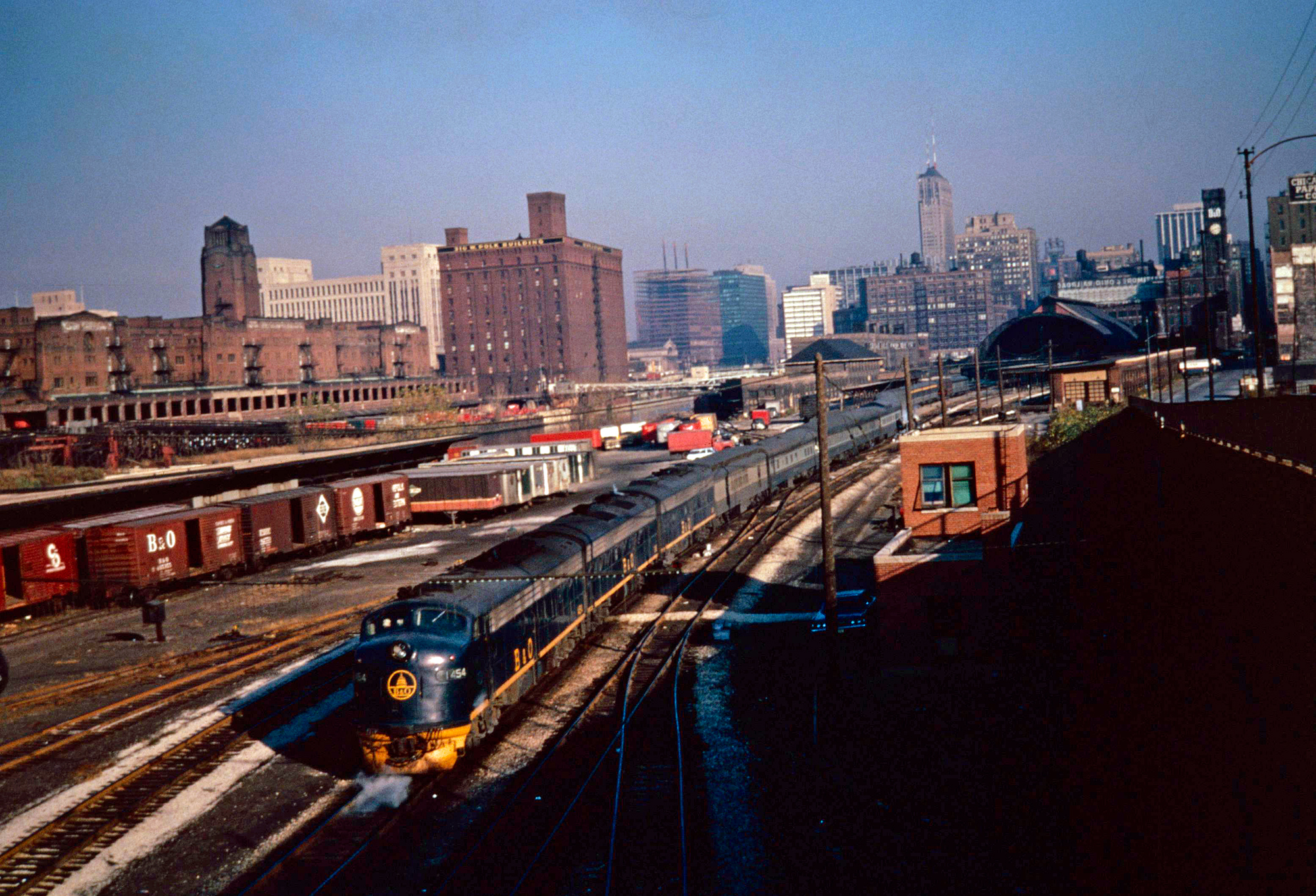 Baltimore & Ohio E9A #1454 (built as #34) leads train #5, the eastbound "Capitol Limited," out of Chicago's Grand Central Station on a fall morning in the late 1960s. American-Rails.com collection.
Baltimore & Ohio E9A #1454 (built as #34) leads train #5, the eastbound "Capitol Limited," out of Chicago's Grand Central Station on a fall morning in the late 1960s. American-Rails.com collection.The railroad even brought back its famed Deer Park spring water and all onboard vegetables were fresh, not frozen or canned. After Amtrak took over it initially canceled all B&O trains, including the Cap.
However, ten years after making its final run under its original creator, Amtrak brought back the train in 1981, operating it over its original route between Washington, D.C. and Chicago where it continues to remain in service today.
Amtrak
Amtrak's Capitol Limited still connects Washington D.C. and Chicago. The route boasts several significant stops, serving as a vital link within the United States railway network. Notable stops include Harpers Ferry in West Virginia, Pittsburgh in Pennsylvania, Cleveland in Ohio, and South Bend in Indiana, among others.
This noteworthy train is recognized by the numbers 29 and 30 on the timetable. Train 29 travels westward from Washington D.C. to Chicago, and the reverse, eastward trip, is carried by train 30.
Amtrak provides a range of on-board services to make the journey on the Capitol Limited as comfortable as possible. These include reclining coach seats, private rooms, a dining car and a café, free WiFi, and even checked baggage service at select stations.
The exact travel time varies due to differing factors, but generally spans around 17 hours and 25 minutes, offering ample time for passengers to unwind, relax, and soak up the countryside's scenic beauty.
The train's route stretches an impressive length of approximately 764 miles across several states, truly embodying the spectrum of American landscapes and cityscapes.
The Capitol Limited's termi offer numerous connecting Amtrak train services. In Washington D.C., the Silver Meteor and Cardinal connect passengers to the south and southeastern U.S., while in Chicago, the Southwest Chief and Empire Builder offer connectivity to the western U.S.
Several Amtrak partner bus services further diversify the reach of the Capitol Limited, providing passengers with an extended web of travel opportunities.
Traveling on this train reveals a panorama of the American heartland, offering passengers a myriad of diverse landscapes. Historic cities, industrial towns, stretches of Appalachian Mountains, and the serene Potomac River are among the many scenic highlights noted by many passengers.
From the historical sites within the charismatic cities of Washington D.C. and Chicago to the quaint charm of Harpers Ferry or the deep riverside woods of Cumberland, the sights available on this route provide a unique cross-continental picture.
The Capitol Limited not only serves as a crucial transportation artery but also tells an extraordinary tale of the expansion and interconnection of America's east and midwest regions.
The train has upheld its legacy of offering reliable and comfortable transportation while presenting a broad taste of America's heartland to its passengers.
Tracing back to 1923, the service, formerly the B&O's (Baltimore and Ohio) Capitol Limited, connected the same two cities and shared a similar route with today's version.
Historically, the train played an essential role in supporting the nation's growth and development, serving communities and contributing to economic activity in the areas it connects.
Today, its cars feature long-haul amenities, such as superliner sleeping cars, bi-level Superliner coaches, Sightseer lounge cars, and more. Riding aboard is a journey of convenience, historical exploration, and scenic appreciation.
Amtrak remains committed to upholding the historic legacy of the Capitol Limited while constantly innovating towards a more environmentally friendly, efficient, and passenger-centric future.
Planning a journey on this route also allows one to explore numerous on-route attractions, such as the John F. Kennedy Center in Washington D.C., Navy Pier in Chicago, Harpers Ferry National Historical Park, and the Carnegie Museum of Natural History in Pittsburgh.
Whether one is a seasoned railway enthusiast, historian, or casual traveler seeking an efficient and exciting transportation choice, the Capitol Limited offers an unparalleled experience.
Ultimately, it is more than just a train ride – it's a journey through the heart of America, connecting individuals, landscapes, and histories, and continuing to drive the nation's growth and development.
Sources
- Reynolds, Kirk and Oroszi, David. Baltimore & Ohio Railroad. Osceola: MBI Publishing, 2000.
- Schafer, Mike. Classic American Railroads. Osceola: MBI Publishing, 1996.
- Schafer, Mike and Welsh, Joe. Streamliners, History of a Railroad Icon. St. Paul: MBI Publishing, 2003.
- Welsh, Joe. Baltimore & Ohio's Capitol Limited And National Limited. St. Paul: MBI Publishing, 2007.
Contents
Recent Articles
-
Montana Short Line Railroads: A Complete Guide
Apr 01, 25 10:51 AM
Montana may be one of the nation's largest states but contains few short line railroads. Learn more about these systems here. -
Missouri Short Line Railroads: A Complete Guide
Apr 01, 25 10:33 AM
Missouri is home to a handful of short lines, many centered around St. Louis. Of note is the Arkansas & Missouri. Learn more about these systems here. -
Mississippi Short Line Railroads: A Complete Guide
Apr 01, 25 10:25 AM
The state of Mississippi is home to a surprising number of Class III short line railroads. Learn more about all of them here.
